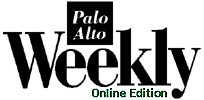Publication Date: Wednesday, July 11, 2001
COURTS
Prosecution tries to crack Fitzhugh alibi
Prosecution tries to crack Fitzhugh alibi
(July 11, 2001) Coroner testifies body moved to look like a fall
by Bill D'Agostino
Santa Clara County Coroner Gregory Schmunk testified last week that Kristine Fitzhugh was likely murdered in her kitchen, where the coroner discovered blood diluted with water, as if someone tried to clean it up. He added her body was placed in the basement to make it look like she had fallen.
Testifying at the trial of Kristine's husband, Kenneth Fitzhugh, Schmunk refuted defense attorney Thomas Nolan's earlier statement that there wasn't enough blood in the kitchen for the murder to have taken place in that room. Schmunk testified he discovered blood splatters diluted with water in the kitchen, which he felt could have indicated an attempt to clean it up.
Nolan has told the jury he believes the murder occurred in the basement and that an unknown intruder killed Kristine. Deputy District Attorney Michael Fletcher argued in his opening statements that Kenneth Fitzhugh killed his wife in the kitchen, and staged the scene in the basement.
Schmunk's opinion about the murder site was based on a number of factors, the most contentious being the amount of "blood splatter" he discovered in the kitchen and subsequently did not find in the basement. Schmunk generally defined blood splatter for the jury as the wet blood that comes off the weapon or victim as the two impact each other.
Nolan, who had never spoken to Schmunk about the case, seemed shocked by the breadth of the medical examiner's opinions in court, especially in regards to the "blood splatter." Nolan strongly objected to much of his testimony on the basis of the medical examiner's credentials, arguing that Schmunk he didn't have the expertise necessary to discuss splatter in court.
The majority of those objections were overruled by Superior Court Judge Franklin Elia, who at many moments last week seemed to tire of Nolan and Fletcher arguing in open court.
Schmunk also gave his opinion about the nature of Kristine Fitzhugh's injuries. He said she received seven blows to the back of the head, and an uncountable number of blows to the front.
Schmunk stated his belief that she could have been struck on the head by a chair leg or a two-by-four piece of wood, if an object was indeed used, but could not be more specific since no murder weapon was ever found by police.
Kristine Fitzhugh had also been strangled by her assailant.
Witnesses for the prosecution also countered the defense contention that Fitzhugh was outside of Palo Alto when he received a cell phone call the afternoon of the murder.
"I'm in San Mateo as we speak," Kenneth Fitzhugh reportedly told Phyllis Smith, a Palo Alto school district secretary, on the afternoon of his wife's murder. Smith testified she called Kenneth Fitzhugh on his cell phone after his wife had not attended her afternoon class at Duveneck Elementary School.
Smith was worried that Kristine Fitzhugh had been in a car accident, as she had never been late for a class before. Instead, the popular music teacher was found murdered in her home.
Craig Frost, a cell phone expert for Verizon Wireless and the next witness to take the stand after Smith, disputed Fitzhugh's alibi. He told the jury there was no possible way Kenneth Fitzhugh was in San Mateo for that phone call.
According to Verizon records, Fitzhugh's cell phone used a Verizon antenna on University Avenue in Palo Alto for the conversation with Smith. It was not one of the antennas closest to San Mateo, so Frost said it's unlikely Fitzhugh was where he claimed.
Craig further noted the specific antenna Fitzhugh's cell phone used for that conversation faced south, so he believed there was only a small area the defendant could have been located during the time of the call.
One of those places? The Fitzhugh home and the surrounding neighborhood.
In cross-examination, Nolan got Frost to admit no scientific study has proven the reliability pinpointing cell phone locations. In fact, Frost admitted the location of a cell phone in operation cannot be pinpointed exactly.
However, Frost believed certain locations could be eliminated based on which antenna was used. He told the jury he was 95 percent sure Fitzhugh wasn't where he told Smith he was.
To prove his theory, Frost and other Verizon technicians drove a device around different parts of Santa Clara and San Mateo counties to see where the antenna used by Fitzhugh's phone was in service. It only picked up signals in the areas that Frost predicted -- not in San Mateo, San Bruno, or along Highway 101.
Nolan is expected to call his own cell-phone expert later in the trial to dispute the validity of Frost's claims.
Palo Alto Fire Capt. Patrick Lyon Morris testified on Thursday that his three-man team was the first emergency crew on the scene.
Morris remembered that Fitzhugh acted "detached" as he gave CPR to his wife. He acted so calm, in fact, that Morris initially mistook Fitzhugh for a doctor on the scene. E-mail Bill D'Agostino at bdagostino@paweekly.com
| 
